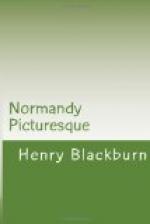We will not venture to say that these old buildings are altogether admirable from an architect’s point of view, but to us they are delightful, because they were designed and inhabited by people who had time to be quaint, and could not help being picturesque. And if these old wooden houses seem to us wanting (as many are wanting) in the appliances and fittings which modern habits have rendered necessary, it was assuredly no fault of the 15th-century architect. They display both in design and construction, most conspicuously, the elements of common sense in meeting the requirements of their own day, which is, as has been well remarked, “the one thing wanting to give life to modern architecture;” and they have a character and individuality about them which renders almost every building unique. Like furniture of rare design they bear the direct impress of their maker. They were built in an age of comparative leisure, when men gave their hearts to the meanest, as well as to the mightiest, work of their hands; in an age when love, hope, and a worthy emulation moved them, as it does not seem to move men now; in an age, in short, when an approving notice in the columns of the ‘Builder’ newspaper, was not a high aspiration.
But in nothing is the attraction greater to us, who are accustomed to the monotonous perspective of modern streets, than the irregularity of the exteriors, arising from the independent method of construction; for, by varying the height and pattern of each facade, the builders obtained to almost every house what architects term the ‘return,’ to their cornices and mouldings, i.e., the corner-finish and completeness to the most important projecting lines. And yet these houses are evidently built with relation to each other; they generally harmonize, and set off, and uphold each other, just as forest trees form themselves naturally into groups for support and protection.
All this we may see at a distance, looking down the varied perspective of these streets of clustering dwellings; and the closer we examine them, the more we find to interest, if not to admire. If we gain little in architectural knowledge, we at least gain pleasure, we learn the value of variety in its simplest forms, and notice how easy it would be to relieve the monotony of our London streets; we learn, too, the artistic value of high-pitched roofs, of contrast in colour (if it be only of dark beams against white plaster) and of meaning in every line of construction.
These, and many more such, sheaves we may gather from our Norman harvest, but we must haste and bind them, for the winds of time are scattering fast. Pont Audemer is being modernised, and many an interesting old building is doomed to destruction; whilst cotton-mills and steam-engines, and little white villas amongst the trees, black coats and parisian bonnets, all tend to blot out the memories of mediaeval days. Let us make the most of the place whilst there is time—and let us, before we pass on to Lisieux, add one picture of Pont Audemer in the early morning—a picture which every year will seem less real.[8]




